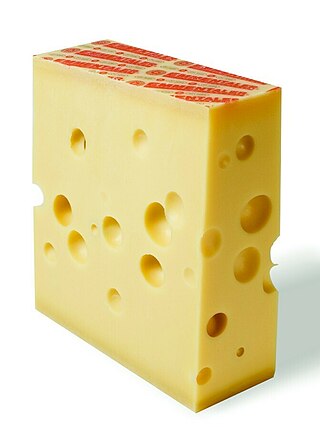Top Qs
Timeline
Chat
Perspective
Eyes (cheese)
Round holes in cheese From Wikipedia, the free encyclopedia
Remove ads
Eyes are the round holes that are a characteristic feature of Swiss-type cheese[1] (e.g. Emmentaler cheese) and some Dutch-type cheeses. The eyes are formed by bubbles of carbon dioxide gas during the cheesemaking process. The gas is produced by various species of bacteria in the cheese.[2]

Swiss cheese
In Swiss-type cheeses, the eyes form as a result of the activity of propionic acid bacteria (propionibacteria), notably Propionibacterium freudenreichii subsp. shermanii.[3][4] These bacteria transform lactic acid into propionic acid and carbon dioxide, according to the formula:
The CO2 so produced accumulates at weak points in the curd, where it forms the bubbles that become the cheese's eyes.[3] Not all CO2 is so trapped: in an 80 kg (180 lb) cheese, about 20 L of CO2 remain in the eyes, while 60 L remain dissolved in the cheese mass and 40 L are lost from the cheese.[1]
In Swiss cheese production, the number and size of eyes declined in the 2000s. This was the result of increasing standards of hygiene, which reduced the number of dust particles in the milk around which gas bubbles form. In 2025, the Swiss Federal Administrative Court approved the addition of hay flower powder (Flores graminis) to the milk during cheesemaking, to allow for eyes of the typical number and size to form.[6][7]
Remove ads
Dutch cheese
In Dutch-type cheeses, the CO2 that forms the eyes results from the metabolisation of citrate by citrate-positive ("Cit+") strains of lactococci.[1]
Bibliography
- Polychroniadou, A. (2001). Eyes in cheese: a concise review. Milchwissenschaft 56, 74–77.
References
- Fox, P.F., ed. (13 October 2004). Cheese: Chemistry, Physics, and Microbiology, Volume 1: General Aspects. Academic Press. ISBN 978-0-12-263652-3.
Footnotes
Wikiwand - on
Seamless Wikipedia browsing. On steroids.
Remove ads
